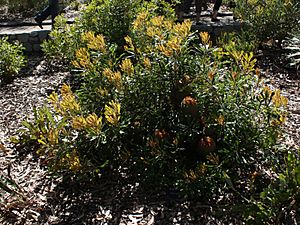Woolly banksia facts for kids
Quick facts for kids Woolly banksia |
|
|---|---|
 |
|
| Banksia baueri inflorescence | |
| Scientific classification |

The Banksia baueri, also known as the woolly banksia, is a special type of shrub found only in the southwest part of Western Australia. It has leaves with jagged edges and a very unique, large, and fuzzy flower cluster. These flowers can be cream, yellow, or brown, and the plant also produces hairy fruits.
Contents
What Does the Woolly Banksia Look Like?
The woolly banksia grows as a bushy shrub with many branches. It can reach about 0.5 to 2 meters (1.6 to 6.5 feet) tall and spread up to 3 meters (10 feet) wide. Unlike some other plants, it doesn't have a special woody base called a lignotuber that helps it regrow after a fire.
Its bark is thin and grey with long cracks. When new parts of the plant grow, they are covered in soft, pale brown fur. New growth usually happens in the summer.
Leaves and Flowers
The leaves of the woolly banksia are usually shaped like a narrow egg, wider at one end and tapering down to a short stem (called a petiole). They are about 40 to 130 millimeters (1.5 to 5 inches) long and 5 to 35 millimeters (0.2 to 1.4 inches) wide. Their edges are serrated, meaning they have small, sharp teeth like a saw.
The flower cluster, called an inflorescence, takes a long time to grow, about 5 to 6 months. It can become very large, up to 120 to 130 millimeters (4.7 to 5.1 inches) across and 170 millimeters (6.7 inches) tall. These big, fuzzy flower spikes grow on short side branches.
The individual flowers are cream, yellow, or brown and feel hairy. Each flower has a part called a perianth that is about 50 to 70 millimeters (2 to 2.7 inches) long. It also has a pistil, which is the female part of the flower, about 50 to 58 millimeters (2 to 2.3 inches) long with a smooth style.
Fruit
After the flowers, the plant produces fruit. These fruits are hairy, oval-shaped pods called follicles, and they are about 12 to 17 millimeters (0.5 to 0.7 inches) long.
Where Does the Woolly Banksia Grow?
The woolly banksia is found in three separate areas in southern Western Australia. You can find it from Bremer Bay in the east to Jerdacuttup, and also in the southern Stirling Ranges. It also grows inland to the northwest, between Kweda and Tarin Rock.
These plants like to grow in shrubland or mallee areas. They prefer flat or gently sloping ground. You'll often find them in white or grey sand, or in shallow sand that sits on top of laterite (a type of soil) or quartzite (a type of rock).
Who Discovered the Woolly Banksia?
The woolly banksia was first described by a botanist named Robert Brown in 1830. He described it after a plant collector named William Baxter found it near King Georges Sound in 1829.
The plant was named after two Austrian artists, Franz and Ferdinand Bauer, who drew plants. Ferdinand Bauer had even traveled with Robert Brown on a trip to Australia.
Why is it Called Woolly Banksia?
This plant has many common names, like woolly banksia, possum banksia, woolly-spiked banksia, pussy cat banksia, or teddy bear banksia. All these names come from its large, furry flower spikes, which look soft and woolly!
How Does the Woolly Banksia Help Animals?
A study done in the Fitzgerald River National Park in the 1980s found that the woolly banksia is a very important food source for the honey possum (Tarsipes rostratus) during winter. Honey possums love to drink nectar from flowers, and the woolly banksia provides plenty of it!
Growing Woolly Banksia in Your Garden
The unusual flower spikes of the woolly banksia make it a very attractive plant for gardens. If you want to grow it, it needs soil that drains water well. It also likes to be in full sun or a spot with some shade.
If you plant seeds, they don't need any special treatment to grow. They usually take about 20 to 49 days to sprout.
Images for kids


